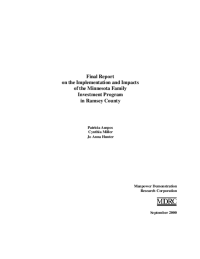Final Report on the Implementation and Impacts of the Minnesota Family Investment Program in Ramsey County
This report examines the implementation and impacts of the Minnesota Family Investment Program (MFIP), which operated as a field trial in Ramsey County (which includes the City of St. Paul) between July 1996 and June 1998. Part of a state welfare reform initiative, the Ramsey County MFIP program (MFIP-R) was designed as a "work first" program which offered welfare recipients financial incentives for work and required them, after they had been on welfare for one year, to participate in job search activities to facilitate their quick entry into the workforce. Seven other counties operated MFIP demonstration programs offering the same financial incentives for work as MFIP-R; but these programs did not require recipients to participate in work-related activities until they had been on welfare for two years, and they offered a broader menu of employment-related activities under the participation mandate.
This study is part of a series of papers and reports produced in an evaluation of MFIP in all eight demonstration counties, which was conducted by the Manpower Demonstration Research Corporation (MDRC) under contract with Minnesota's Department of Human Services (DHS). It is released in conjunction with the final report on the impacts of MFIP in the other seven field trial counties.
The evaluation analyzes the MFIP-R program from several perspectives using several data sources. Information from a recipient survey is used to describe how single-parent MFIP-R recipients experienced the program in Ramsey County and the kinds of jobs they found during the first year after they entered the program. Administrative records data are used to analyze the effects of the program on recipients' employment, earnings, and welfare receipt within 12 months of program entry, compared with Minnesota's traditional Aid to Families with Dependent Children (AFDC) program and its employment and training arm, known as STRIDE. Finally, the study compares the MFIP-R impacts in Ramsey County with the early MFIP results in three urban counties (Hennepin, Anoka, and Dakota Counties).
Key Findings
- MFIP-R staff conveyed a strong work first message, and the majority of single-parent recipients participated in an employment-related activity within the first year after program entry, most of them in the mandated sequence of job search activities.
- Compared with AFDC/STRIDE, MFIP-R substantially increased employment and earnings among single-parent recipients, particularly in the first months after program entry. MFIP-R moved recipients into jobs more quickly than AFDC/STRIDE, and it also boosted the proportion who were employed during all four quarters of the follow-up period. As expected because of the financial incentives for working, welfare receipt was higher among MFIP-R recipients than among AFDC recipients.
- MFIP-R was particularly effective in increasing employment and earnings among recipients who had not worked during the year prior to entering the program.
- Compared with single-parent MFIP recipients who were subject to the MFIP participation mandate in the three other urban counties, MFIP-R recipients heard a stronger work first message, were more likely to participate in a short-term employment-related activity, and were equally likely to participate in an education or a training activity. Comparing the MFIP-R impacts with the MFIP impacts in the three urban counties suggests that MFIP-R produced larger impacts on employment and earnings than MFIP in the first two quarters after random assignment, but it had smaller impacts than MFIP by the end of the first year of follow-up. Because there are important differences among the recipient groups and the time periods in the two studies, these findings cannot be used to draw conclusions about which program was more effective.
- MFIP-R increased employment and earnings levels among two-parent families in Ramsey County, compared with the AFDC program. As anticipated because of the financial incentives for working and streamlining of eligibility for two-parent families, welfare receipt was also higher among the MFIP-R groups. The high proportion of Hmong recipients in the MFIP-R sample makes comparison with the MFIP program for two-parent families inadvisable.






